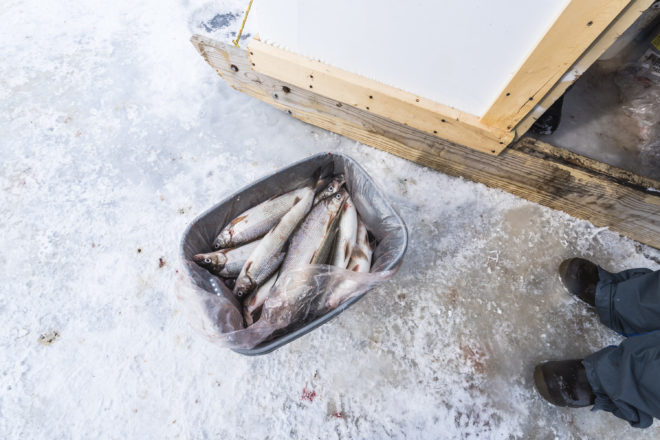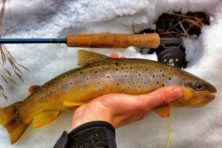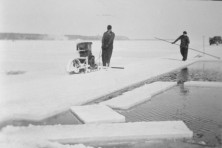WILD THINGS: Early-Season Ice Is No Time to Risk Offshore Exploring
- Share
- Tweet
- Pin
- Share

No ice is safe ice.
No matter how many times that Department of Natural Resources mantra is repeated by agency safety specialists and conservation wardens, it still seems to fall on deaf ears.
With most of central and northern Green Bay still open water last weekend, a powerful offshore wind blowing out of the south should have been enough to keep anglers from fishing anywhere but protected bays and harbors. Instead, dozens of southern Green Bay fishers had to be rescued by airboat after the ice they were on broke loose and floated away.
It’s been very cold since, but windy weather continues to hamper ice formation over the open water. Check the latest progress via satellite images by searching “Lake Michigan MODIS Imagery” online.
If you’re thinking of heading out, talk to an experienced angler who has already been fishing, or visit a reputable bait-and-tackle store. Ask especially about areas to avoid.
Remember: Ice on the vast waters of Green Bay seldom freezes uniformly. Ice depths can and often do vary greatly in even a short distance. In addition, ice-breaking operations are still ongoing, so stay away from the Sturgeon Bay shipping channels and the tracks that lead to the cities of Marinette and Green Bay, or out into the open water of Lake Michigan.
Many hardwater fishers carry safety gear such as ice claws or ice picks, a cell phone in a waterproof case, a life jacket and a length of rope.
Other basic ice-safety tips:• Dress in layers, and use spike-style ice creepers on boots for traction to avoid falls.
• Avoid creek mouths, shallow reefs and narrows that may have current that can cause thin ice.
• Hand and toe warmers come in handy if you’re not in a heated shanty.
• Avoid fishing alone whenever possible, and always tell someone where you’re going and when you plan to return.
‘Free’ Fishing Jan. 15-16
You’ll still need the bait, gear and gas to get there and back, but Jan. 15-16 is Wisconsin’s annual Free Winter Fishing Weekend, when anglers may fish state waters where there is an open season. Visit dnr.wisconsin.gov/topic/Fishing/anglereducation/wheretofish to see locations. No fishing licenses are required, but all other regulations apply.
Bird Count Feb. 18-21
The Great Backyard Bird Count (GBBC) is an annual, four-day event that engages bird watchers of all ages in counting birds to create a real-time snapshot of where the birds are. Everyone is welcome, from beginners to experts. Participants tally the number of individual birds of each species they see during their count period and tally these numbers on the GBBC website.
This year’s count – the 25th annual – is expected to draw more than 300,000 people from around the world. All it takes is at least 15 minutes on one or more days of the count. You tally the numbers and kinds of birds you see from any location. There is no cost to participate.
Last year, GBBC participants across the globe counted more than 6,500 species of birds. You can explore the data and post photos of what you’re seeing at gbbc.birdcount.org.
Meanwhile, Project FeederWatch runs now through April 30. Your bird counts help ornithologists track long-term trends in winter bird distribution and abundance.
New participants receive a research kit with complete instructions, a bird-identification poster, calendar and more. The cost is $18. Learn more about the project at feederwatch.org.
CWD Plan Is Online
Hunters and anyone else who’s interested in the Department of Natural Resources’ (DNR) Chronic Wasting Disease Response Plan can find a link at dnr.wisconsin.gov/topic/wildlifehabitat/cwd.html.
The DNR’s 15-year CWD Response Plan is in effect through 2025. It was developed to fulfill the agency’s public-trust responsibility to manage wildlife and ensure the health of Wisconsin’s wildlife populations. The DNR reviews progress toward meeting its goals and objectives every five years.
Chronic wasting disease is a fatal, infectious nervous-system disease of deer, moose, elk and reindeer/caribou. The DNR began monitoring the state’s wild white-tailed deer population for CWD in 1999, and the first positives were found in 2002.
Early Trout Season
Wisconsin’s early catch-and-release season for trout on many inland waters opened Jan. 1 and runs until May 6, the day prior to the regular-season opener. All licenses and 2021-22 trout regulations apply; check them out at dnr.wisconsin.gov/topic/Fishing/regulations/troutregs.html.
Trout are very fragile in very cold temperatures, so they should not be exposed to the elements for long periods. Release them gently and as soon as possible.
Weekly Water Levels
As of Jan. 7, Lake Michigan was 43 inches higher than the record monthly low set in 2013, but two feet below the monthly high, set in 2020. Lake levels have dropped 17 inches during the past 12 months, including two inches since early December. Overall, water levels are still 13 inches above the 100-year monthly average.



